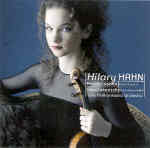Hilary Hahn’s latest release is yet one more sign that this 22-year-old definitely is not a flash-in-the-pan child prodigy, but rather already is one of the most important violinists of this generation. She possesses phenomenal technique, but the mechanics of her playing are more than matched by the clear effort and love she puts into thinking about what she’s playing. (However, her sweetly disingenuous liner notes could be scrapped; we don’t need Hahn to inform us earnestly that Stalin was “one of history’s most jealous and savage dictators.”)
Although the Mendelssohn is thoroughly overrecorded (and the Shostakovich also faces some modern competition, including a recent issue from Ilya Gringolts on DG), Hahn’s version is not to be missed. She shoots the first movement through with energy, yet her tone remains warm and lyrical. The Andante is paced on the slow side, but her choice allows her the time to revel in the movement’s engaging theme. But it’s in the last movement that she really roars; she simply flies through its Allegro molto vivace (at the same speed as Heifetz!) while keeping each note utterly pristine and sharply defined. It’s a fantastic performance, one that easily stands among the greats.
The Shostakovich is not quite as stellar, though in truth it would be hard for anyone to come close to Oistrakh’s definitive recording. Perhaps a fairer comparison would be to another violinist of her age group, Maxim Vengerov (who has recorded both Shostakovich concertos for Teldec). She falls into a discernible pattern within this concerto: she is much more engaged in the faster movements and isn’t quite sure how to handle the slower, more obviously agonized ones. The first movement lacks the haunted, dogged quality that’s so key here, and Hahn settles for mere solemnity instead. Her Scherzo certainly is razor-sharp and she zips off at the speed of light at the end of the Allegro, but she doesn’t allow the Jewish-influenced rhythms and coloring of that Allegro to blossom. (Neither does Janowski, who keeps this section entirely foursquare.) Again, the slower Passacaglia is not as utterly desolate in feeling as it should be, but the virtuosic Cadenza shows her at her most yielding and flexible. Neither Hahn nor Janowski seems quite sure how to handle the crazed whirl of the final Burlesque; it rushes by as they sacrifice snarl for speed. But in terms of sheer technical accomplishment, Hahn is breathtaking.
Strangely enough, Sony didn’t bother to list the two conductors (Wolff in the Mendelssohn, Janowski in the Shostakovich) on the disc’s cover. While that oversight might be a slight to those gentlemen, there’s a certain logic to it: this is Hahn’s show, and everyone else–including the conductors–is here as a backup player, not as a partner. The Oslo Philharmonic keeps pace with Hahn, and the contours of each concerto’s orchestration are thrown into bright relief with the forward, round sonics of the engineering.
Is this a flawless album? No. I can’t imagine that Hahn won’t want to record the Shostakovich again in a decade or two, when she has a little more life experience and artistic maturity behind her. But the Mendelssohn shows the violinist perfectly pitched, and the Shostakovich too shows glimmers of the deep understanding that you expect Hahn to cultivate in coming years to match her unquestionable technique. This album is a snapshot of where a truly great violinist stands at this point in her life. Anyone who cares about making such observations–or who just loves great violin playing–should hear this disc.
































